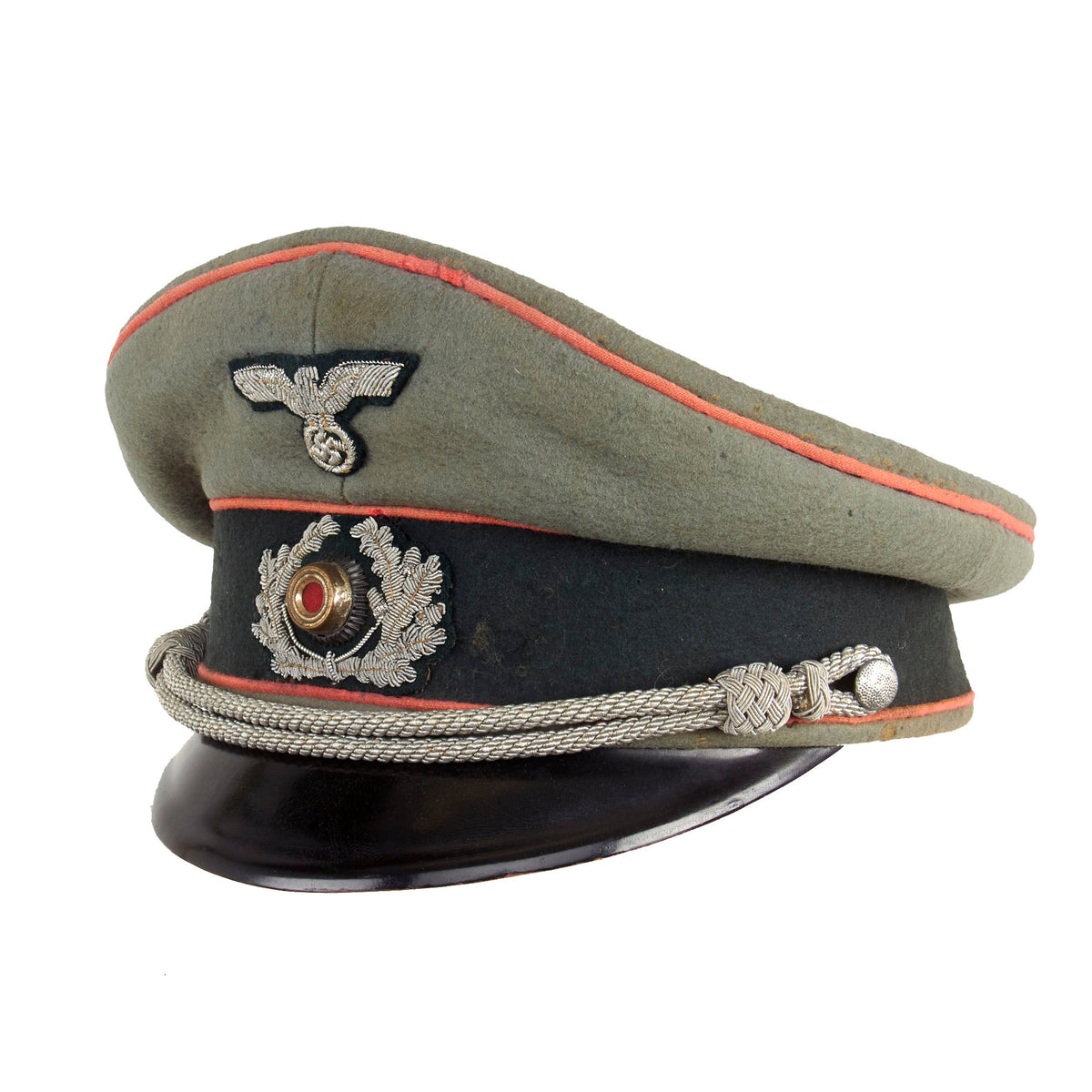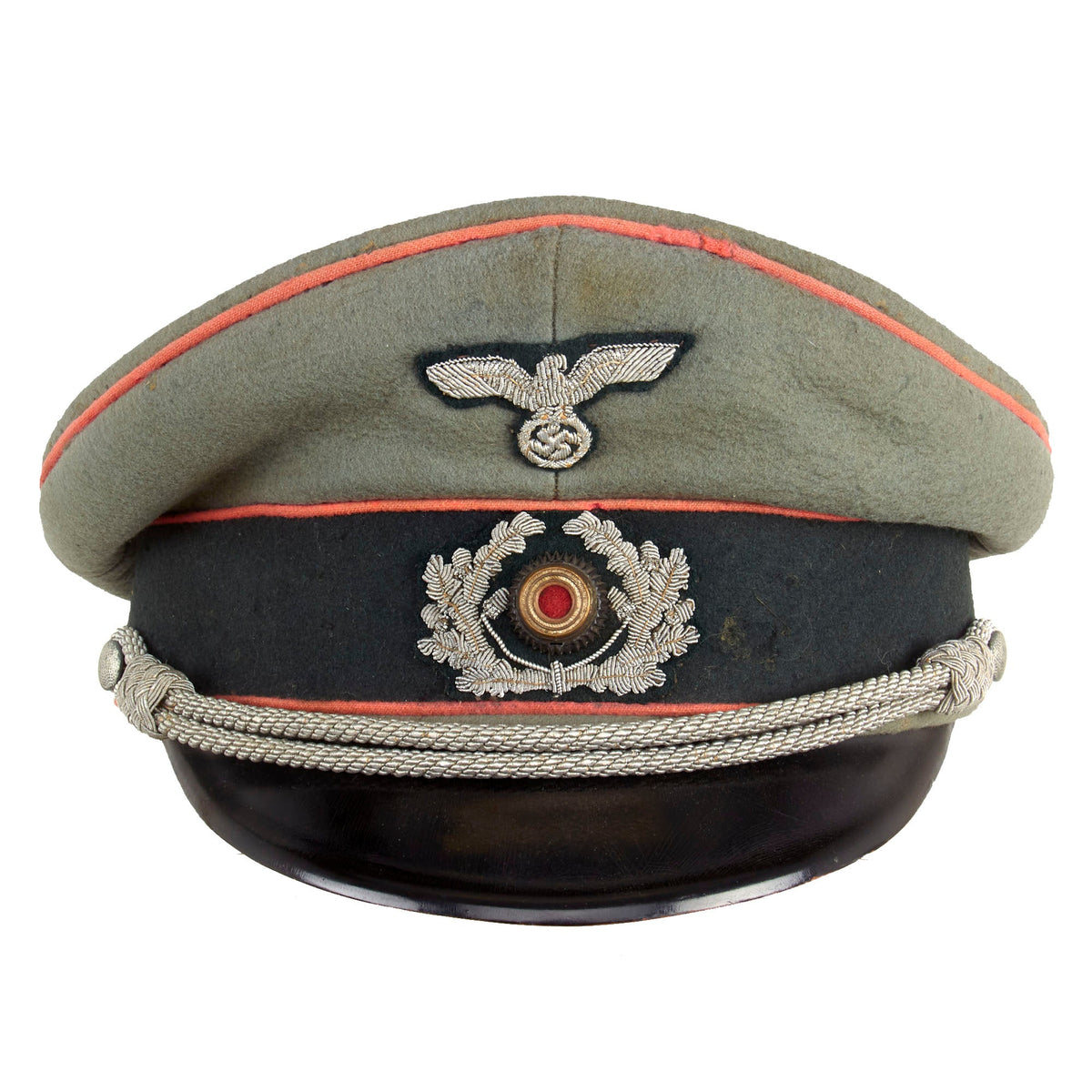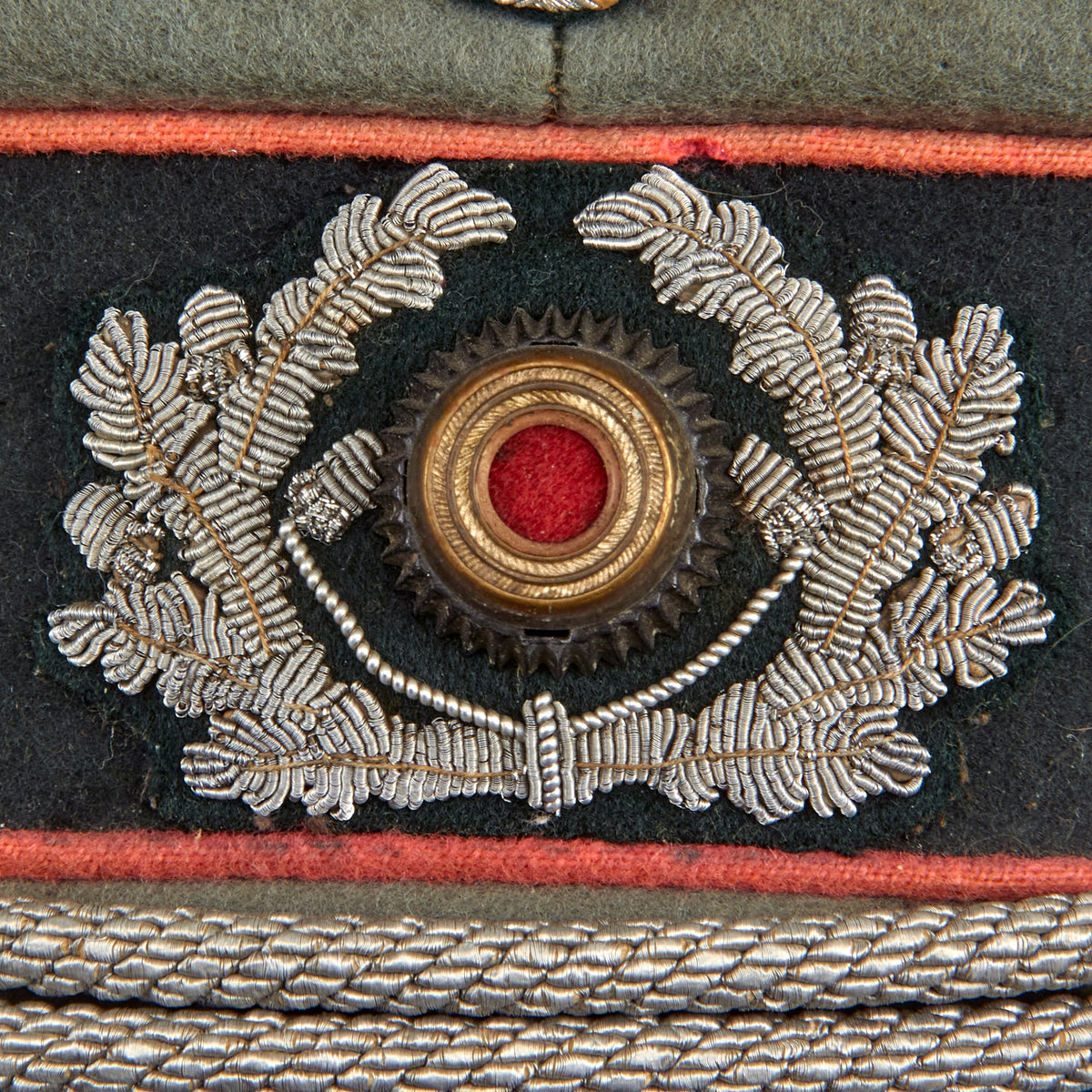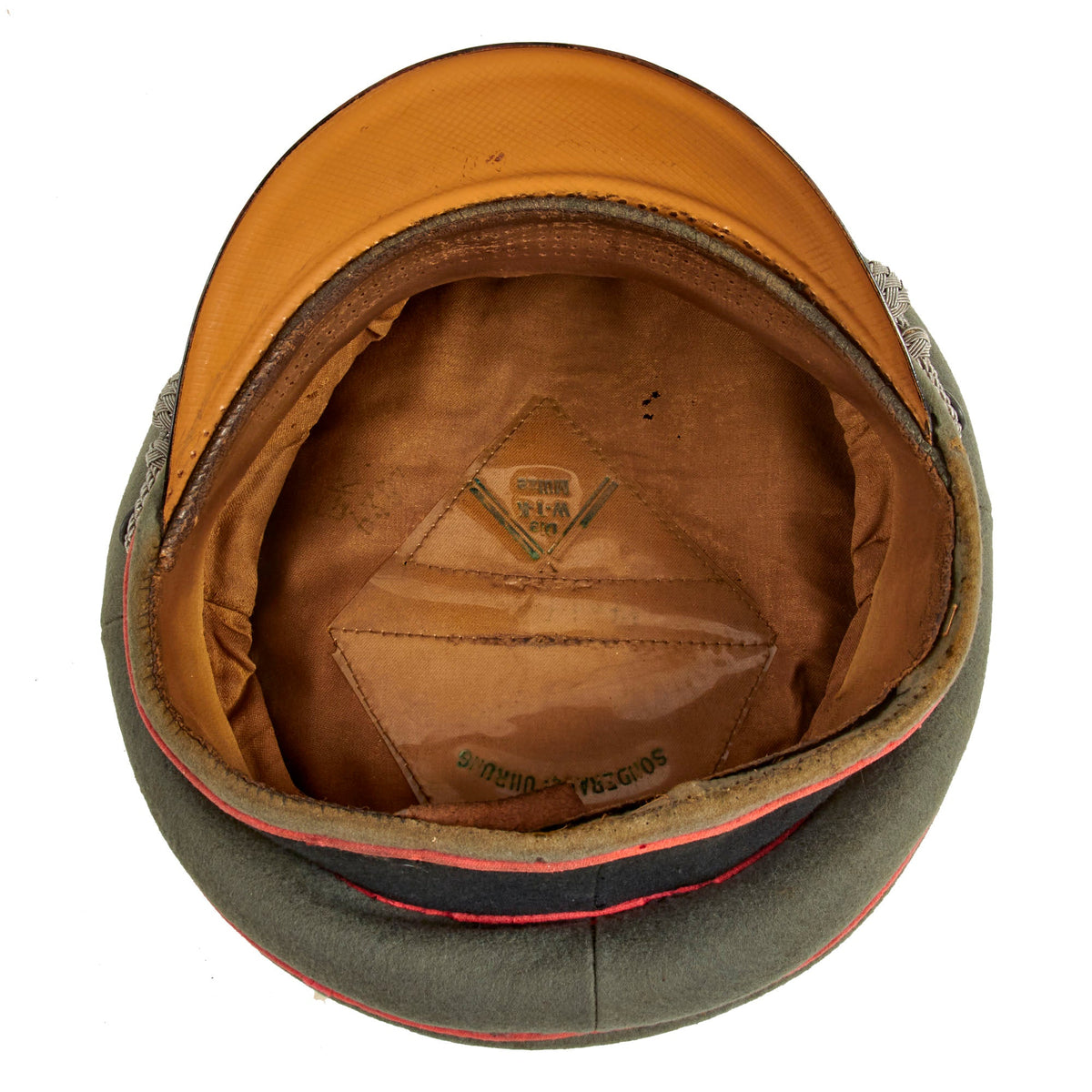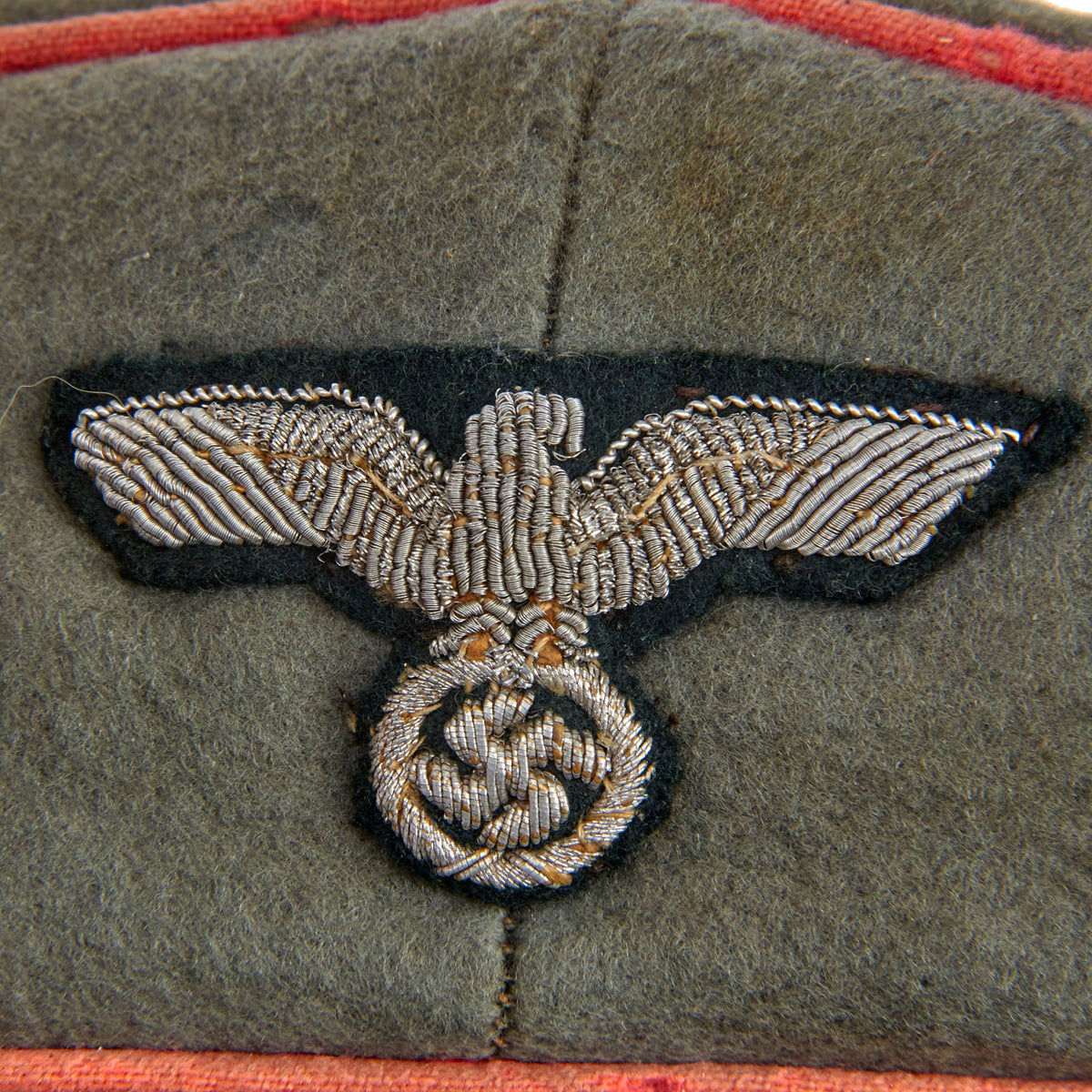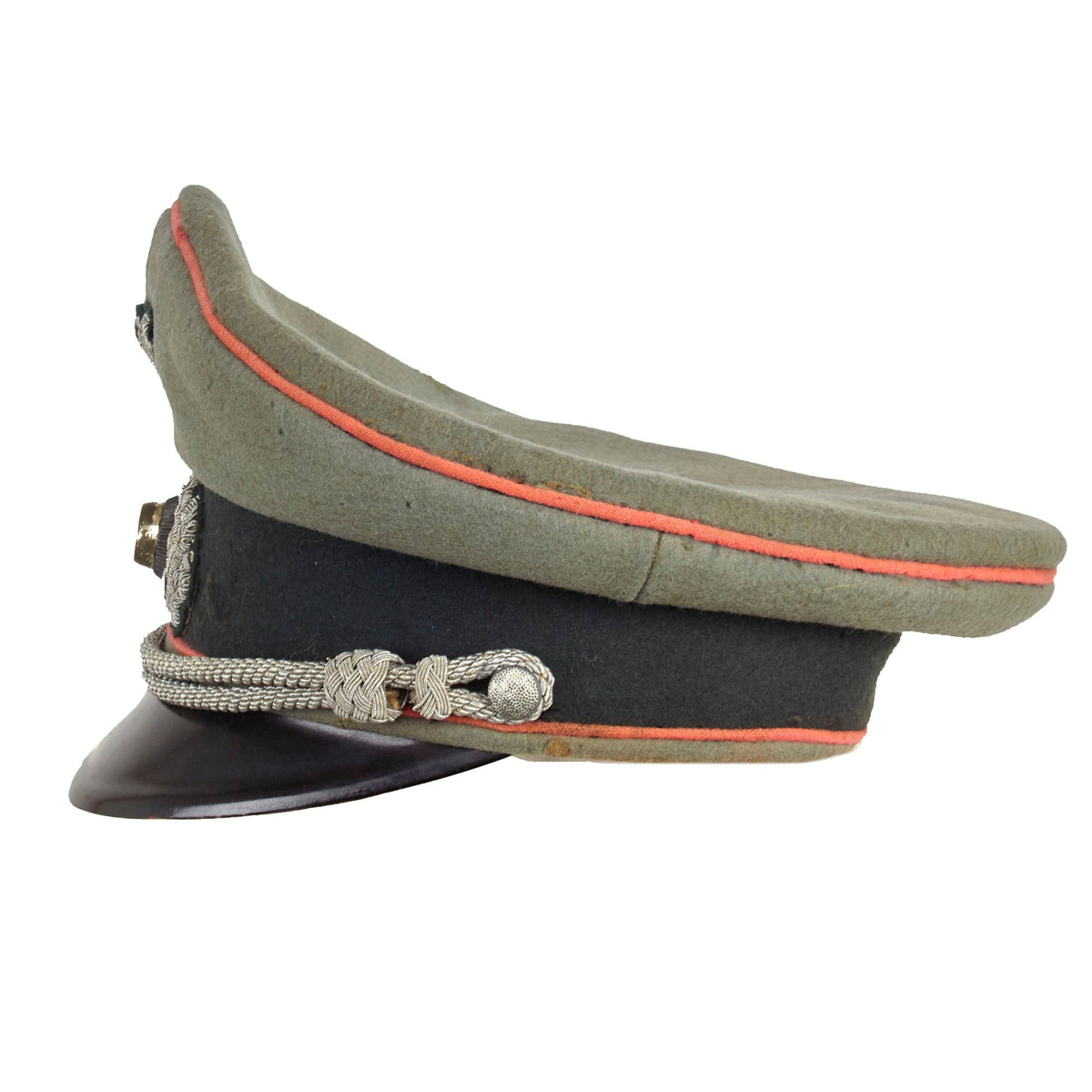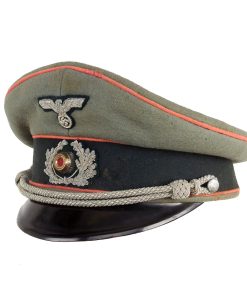Original German WWII Heer Panzer Armored Corps Officers Schirmmütze Visor Crush Cap with Embroidered Bullion Insignia Original Items
$ 1.895,00 $ 473,75
Original Item: Only One Available. This cap is a wonderful well broken-in example of a German WWII Wehrmacht Heer Army Panzer Armored Corps Officer’s Schirmmütze (visor cap). The cap has a lovely “Crushed” or “saddle-form” shape that is highly desirable, accomplished by removing the crown support stiffener ring. It features the typical feldgrau (field gray) “doe skin” weave wool construction with a flaschengrün (dark bottle-green) “badge cloth” band and a traditional high forward crown. The also has matching rose-pink (rosa) piping along the top edge and flanking either side of the band. This is the Waffenfarbe (Corps Color) for the Panzertruppen (Armored Forces), as well as Kraftfahrkampftruppe – Kraftfahrtruppen (Motor Vehicle Combat Troops). It has the correct silver bullion chin strap, indicating that it is for an officer.
The insignia on this cap are both the very early fully hand embroidered aluminum bullion type, and have a fantastic lightly worn look. The peak eagle is woven onto a forest green background, with some tan threads that help hold the design in place. The bullion shows some minor fraying, but there are no loose strands or oxidation we can see. The oak leaf wreath is also very well executed, woven onto the same green background, and surrounds a non-magnetic metal cockade, which has a red felt insert in the center. There is just a bit of fraying on the wreath, and the plating on the brass cockade has worn through, giving it a lovely look. Really a great set of early pattern insignia.
The chin strap is attached with the standard pebbled buttons on either side of the cap, which show a bit of finish loss. The vulcanfibre visor has a smooth black leather-look upper, exhibiting only light wear along the edge, and is beige with cross hatching on the underside. It also has a lovely pattern of light crazing and checking on the black enamel finished top. The tan leather sweatband is still in good condition, supple but also showing staining and wear. The stitching holding it to the cap has rotted out over at least 1/3 of the circumference, and there is wear on the bottom rim of the cap as well.
The inside of the cap is lined with golden brown rayon faux silk fabric, which is in very good condition with no tearing, though it definitely does show staining from use and wear. There is also some writing on the lining, however we cannot make out what it says. The top celluloid sweat shield diamond is almost fully intact, with just a bit of the corner missing, and the stitching is completely intact. Towards the top it reads SONDERAUSFÜHRUNG (Special Version), while at the bottom there is a small logo and the following:
DIE
W-T-K
Mütze
We have unfortunately not been able to identify the maker based on this. There is no size marked, but it seems to be a 57-58cm. Overall condition is very good, however it definitely shows damage from long use. There are some stains on the top, as well as mothing in areas. This is definitely a cap that was “really there”, with a patina that impossible to duplicate.
A great “salty” example of a classic hat worn by German Panzer Officers in WWII with a fantastic “crushed” shape. Very impressive and ready to display!
The German Schirmmütze Visor Cap:
The visor cap (Schirmmütze) was an important part of the headgear worn by German uniformed military, civil, paramilitary and political organizations during the Third Reich. This was the standard cloth headgear worn as a part of the service uniform. Visor caps were worn outdoors as well as indoors, and were often required to be worn by all personnel on duty. Visor caps were made in versions specific to each organization and were often further differentiated through the use of insignia, colored piping, or style of chin cord, to indicate rank, role or branch. The insignia used on these caps ranged from simple stamped metal emblems, to elaborate hand embroidery. Visor caps were issued to enlisted soldiers and NCOs in the military and in some other organizations. Officers had to purchase their own hats, and lower ranks could choose to purchase caps that were of a higher quality than the rather basic, issue examples. The private purchase caps were generally made in very high quality, with fine materials. A wide variety of fabrics were used, from Trikot and doeskin, to heavy wool, or even lightweight white fabric for summer wear. In the military, issue of these caps was generally suspended shortly after the outbreak of the war, but they continued to be worn by some troops until the end of the war.
Fast Shipping with Professional Packaging
Thanks to our longstanding association with UPS FedEx DHL, and other major international carriers, we are able to provide a range of shipping options. Our warehouse staff is expertly trained and will wrap your products according to our exact and precise specifications. Prior to shipping, your goods will be thoroughly examined and securely secured. We ship to thousands clients each day across multiple countries. This shows how we're dedicated to be the largest retailer on the internet. Warehouses and distribution centres can be located throughout Europe as well as the USA.
Note: Orders with more than one item will be assigned a processing date depending on the item.
Before shipping before shipping, we'll conduct a thorough inspection of the items you have ordered. Today, the majority of orders will be delivered within 48 hours. The delivery time will be between 3-7 days.
Returns
The stock is dynamic and we cannot completely manage it because multiple stakeholders are involved, including our factory and warehouse. So the actual stock may alter at any time. It's possible that you may not receive your order once the order has been made.
Our policy is valid for a period of 30 days. If you don't receive the product within 30 days, we are not able to issue a refund or an exchange.
You can only return an item if it is unused and in the same state as the day you received it. You must have the item in its original packaging.
Related products
Uncategorized
Uncategorized
Uncategorized
Uncategorized
Uncategorized
Uncategorized
Uncategorized
Uncategorized
Angolan Rebel 1970s era 60mm Inert Display Mortar from Angolan Civil War Original Items
Uncategorized
Band of Brothers ORIGINAL GERMAN WWII Le. F.H. 18 10.5cm ARTILLERY PIECE Original Items
Uncategorized
Uncategorized
Uncategorized
Uncategorized
Uncategorized
Uncategorized
Uncategorized
Uncategorized
Uncategorized
Armored Burgonet Helmet & Polearm from Scottish Castle Leith Hall Circa 1700 Original Items
